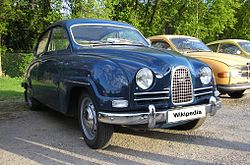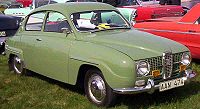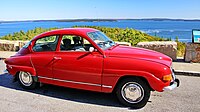Saab 96
| Saab | |
|---|---|
|
Saab 96 DeLuxe (1964)
|
|
| 95/96 | |
| Production period: | 1960-1980 |
| Class : | Lower middle class |
| Body versions : | Limousine , station wagon |
| Engines: |
Gasoline engines : 0.84–1.5 liters (28–50 kW) |
| Length: | 4030-4180 mm |
| Width: | 1570 mm |
| Height: | 1470 mm |
| Wheelbase : | 2490 mm |
| Empty weight : | 950 kg |
| Previous model | Saab 93 |
| successor |
Saab Lancia 600 Saab-Valmet Horizon |
The Saab 96 was from March 1960 to January 1980 of Saab produced. It was the slightly modified successor to the Saab 93 and initially had its 3-cylinder two-stroke engine . The station wagon was named 95 .
Model history
The body and engine were only slightly modified from the predecessor type 93. The water-cooled three-cylinder two-stroke engine with a displacement of 850 cm³ initially developed 28 kW (38 hp).
In 1962 the Saab GT 750 was replaced by the 96 Sport. Outwardly, it hardly differed from the basic model. However, the engine has undergone a major overhaul to improve performance. Each cylinder was supplied by a separate carburetor , the compression ratio increased to 9: 1. As a result, the 0.85-liter engine achieved an output of 52 hp (38 kW) at 4500-5000 / min, and delivered a maximum torque of 9.5 kpm (93 Nm) at 3500 / min. This enabled an acceleration from 0 to 80 km / h in 10.5 s and a top speed of 145 km / h. Disc brakes on the front wheels also ensured better deceleration. In contrast to the basic models, fresh oil lubrication was used on the 96 Sport. For this purpose, a special system was developed in which the oil reached the lubrication points directly and was not sucked in via the fuel-air mixture, as is usually the case with two-stroke engines.
The Saab 96 achieved numerous successes in major international rallies. In 1962 and 1963, the Monte Carlo Rally achieved notable overall victories . This had a major impact on the Swedish manufacturer's increasing exports. As suitable as the two-stroke engine may have been for sporting competitions, its disadvantages in everyday traffic had become obvious and insoluble (high fuel consumption, strong exhaust emissions, uncultivated idling). In 1967, Saab also switched to a four-stroke engine , with the four-cylinder V engine being taken over from the Ford Taunus . The vehicle was produced in its basic form until 1980. The annual output remained at a rather low level at just under 30,000 vehicles per year.
The combination version 95 ran parallel to the 96 in the Saab parent plant in Trollhättan . Behind the steeply sloping stern with a flap that could be opened upwards, there was a fold-out third bench that was mounted against the direction of travel.
Facelift
1963
In the fall of 1963, the front of the vehicle and the radiator grille were changed ("long nose" instead of "round nose").
1964
In the 1964 model year, a dual-circuit braking system was introduced, and with the 1965 model year, the standard model, like the GT, received three carburettors, which increased the power to 42 hp (31 kW).
1967
Saab equipped the 96 with a four-stroke engine. After testing different engine types from various manufacturers (including boxer engines from Hansa , V4 engines from Lancia and a Triumph in-line four-cylinder), the decision was made to use a V4 engine from the German Ford works with a displacement of 1.5 liters, as it was in the Taunus region from 1962 12 sts had been used. With this engine, the 96 accelerated from 0 to 80 km / h in 12.5 seconds.
Even after the Saab 99 appeared , the 96 was continued to be built.
1969
In early 1969, the 96 received a facelift that brought square headlights. There have been various other revisions, including a larger front and rear window and three-point belts.
1974
From spring 1974 a black plastic radiator grille was installed. The black safety bumpers, similar to those of the Saab 99, were the most important external change in autumn 1975. Many small technical changes followed in the 1976 model year. The third row of seats was dispensed with on the 95, but the same rear seats and the same tank as on the 96 were installed. The vehicles were now called 95L and 96L.
1977
The last facelift was 96 and 95 in the summer of 1977. New rear lights, a rear spoiler lip and large front combination lights changed the appearance. The model name was 96 GL / 95 GL.
With this last revision, the Kombi 95 received the same front seats as had been installed on the 96 since 1977. The Swedish production in Arlöv near Malmö ended in April 1978. Until the beginning of 1980, the model was still being built by Valmet Automotive in Uusikaupunki (Finland).
The 1979 vintage only differed from the previous year in small details. Most of the Saab 96 registered in Germany date back to 1979. Production ended in autumn 1979 after production of the 1980 vintage had started.
Combi coupe
In 1976 the Italian coachbuilder Coggiola designed a three-door station wagon with a steeply inclined C-pillar based on the 96 . Coggiola made a prototype that still exists; there was no series production.
technology
- Three-cylinder in-line two-stroke engine (1960 to 1966)
- Bore × stroke: 70 × 72.9 mm
- Displacement: 841 cm³
- Maximum power:
38 hp (28 kW); 1960–1964
40 hp (29 kW); 1965
42 hp (31 kW); 1966-1968
- Four-cylinder V four-stroke engine (from 1966/1967)
- Bore × stroke: 90 × 58.86 mm
- Displacement: 1498 cm³
- Max. Power: 62–68 hp (48.5–50 kW)
- Four-cylinder V-four- stroke engine (from 1971/1974, only for US export)
- Bore × stroke: 90 × 66.8 mm
- Displacement: 1699 cm³
- Max. Power: 55–68 hp (40–50 kW)
- Transmission: mechanical, 3 gears with freewheel , I. unsynchronized, from 1961 also fully synchronized four-speed transmission
- Frame: self-supporting body
- Suspension: independent front suspension, with double wishbones and coil springs; rear rigid axle and coil springs
- Brakes: drum brakes , later front disc brakes
- Top speed: 125–152 km / h
End of production
On January 11, 1980, the last copies left the production lines in Uusikaupunki during a ceremony. The last copy belonged to a special series of 300 pieces in blue metallic paint. This farewell model was equipped with 5 inch wide light alloy rims from Ronal and wide tires. The interior was made of blue plush.
Including the 2,820 vehicles from 1980, a total of 547,221 examples of the Saab 96 were produced. Of the combination version 95, 110,527 pieces were produced.
Web links
Individual evidence
- ↑ Swedish two-stroke passenger cars. In: Motor vehicle technology 10/1962, pp. 423-425















